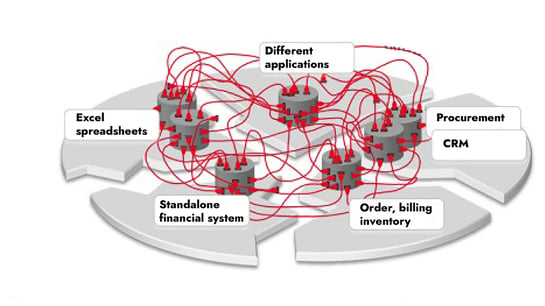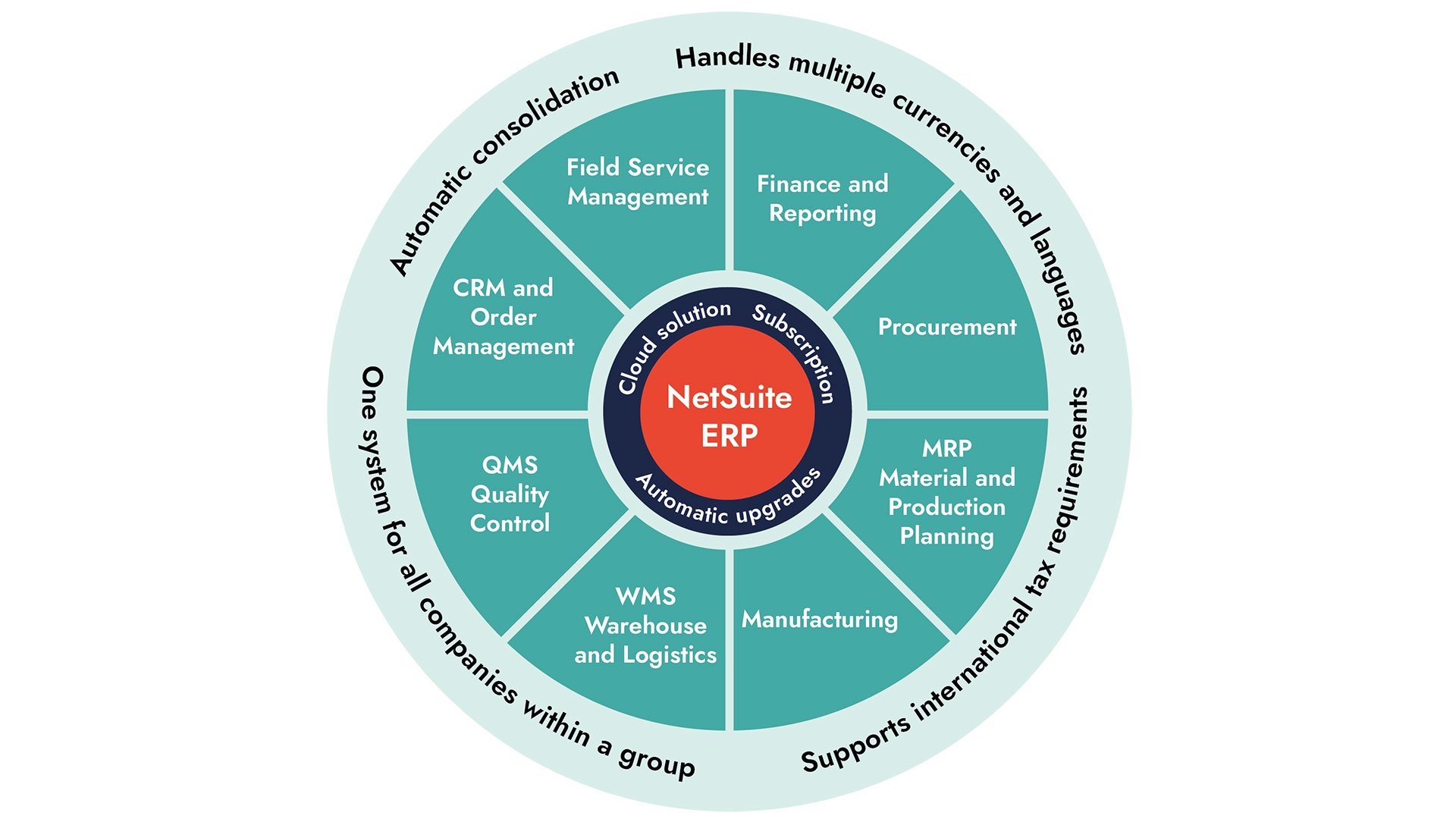Five Signs That It’s Time for a New ERP

Over the years, companies have pieced together multiple applications to run their operations from accounting to order fulfillment, to sales and marketing. This infrastructure lacks many of the capabilities that companies need, provides limited visibility into essential business information and will not enable companies to adapt to changing market conditions and new business models.
Unfortunately, this piecemeal approach results in companies trying to grow by adding even more systems or niche applications—which often aren’t integrated with each other. This application complexity results in manual tasks and bottlenecks, and increasing risks and errors.

NetSuite has worked with businesses of all sizes and industries for more than 20 years. While these businesses are diverse, they experience similar challenges in dealing with systems that are outdated or they’ve outgrown.
What follows is a summary of many of the issues that businesses typically face, and why so many have decided to move to NetSuite – the number one cloud ERP. If you are concerned that your current systems are holding your business back, you should know that you are not alone—but there is a better way.
Five Triggers That Indicate Your Current Systems Are Failing Your Business
Running complex business processes across areas such as financial management, revenue management, fixed assets, procurement, order management, billing, inventory management, services delivery and more is not possible with separate systems.
Moving to a single, integrated cloud platform is a better solution, but companies may not recognize the signs that their current systems are limiting the business. Manual processes, lack of real-time data, errors and poor visibility all hinder the ability to make important business decisions. Look out for any of these five warning signals.
1. It’s difficult to find out what’s really happening across the business in real time.
Most systems are designed for an era when companies could wait until the end of the month to get the data they need. That’s not the case today— consolidated views and up-to-the-minute reporting can make the difference between thriving and barely surviving.
Small teams at a single location can sometimes get by without a fully automated system because they are close enough to the action. But as a company continues to grow, opens new subsidiaries, or allows employees to work remotely, the information that must be exchanged increases exponentially.
Additionally, the data needed for timely and accurate business decisions is buried within multiple systems.
Here are some indicators that your reporting capabilities aren't meeting your organization's needs:
• Team members waste time playing “Hunt for the Spreadsheet”. Growing businesses inevitably reach a stage where employees rely on spreadsheets to fill the information gap since data lives in so many separate systems. Employees end up spending more time searching for data than actually analyzing it and making decisions.
• Reports are error-prone and out-of-date. Businesses using manual processes may need to reenter sales orders into their financial system, reconcile customer information manually or manage SKUs across multiple applications. Reporting errors are inevitable and decisions are often made based on out-of-date, incomplete or inaccurate information.
• Reports take too long to run. With disparate systems, it’s easy to hit performance bottlenecks but solving them is more difficult. When reports take too long to run, it’s a sign that the amount of data the business has amassed has grown too large for its systems to report on it.
• It is impossible to get a comprehensive view across all business units. When businesses grow, it is common that financial information for different subsidiaries or departments are managed in different accounting systems. The transfer and consolidation of the financial information is often manual and can result in errors. In addition, it is difficult for management to gain insight into how the company is performing.
2. Manual processes are used to enter and reconcile data across systems.
Today, it’s frustrating for suppliers, customers and business managers to wait for answers while information is manually transferred between systems. Incompatibilities between systems and imperfect integrations have left employees copying data between systems.
These symptoms are a sign that it may be time for your business to transition to a cloud platform like NetSuite:
• Sales orders, order entry and invoicing are paper-based. Your employees may spend hours every week manually entering order information into the invoicing system, while someone else copies invoice details into a sales compensation spreadsheet. Data entry errors lead to invoice queries and month-end crises that must be resolved.
• Incomplete customer information results in unhappy customers. When some customer information resides in sales spreadsheets, while others are stored in separate applications, there is no way to know which data is most current, accurate and reliable. Invoices may be sent to the wrong customer address or contact information may be out-of-date.
• Approval processes are slow and disjointed. When employees have to pass paperwork around or reconcile data, simple processes like expense claim approvals or routine contract signatures can take days or weeks to finalize.
• Financial consolidation takes ages. Manually entering data in multiple systems is time- consuming and the finance team works late every month to consolidate financial reports. Yet as hard as they work, managers are still unhappy because their weekly and monthly reports are delayed.
• Sales forecasting and budgeting processes rely on guesswork, rather than facts. Since it is difficult to get historic information in the right format in a timely manner, employees put figures in spreadsheets based on guesswork. Even though the actual data exists somewhere, it’s too hard to find and extract.
3. Sales are lost because employees can’t get information to where it’s needed fast enough.
Customers expect to see real-time stock levels and get a confirmed (or tentative) delivery date at the same time they place their order. But this level of real-time responsiveness is impossible with limited or disparate systems, inhibiting your competitive edge in the market.
Here are some warning signs that reliance on separate systems may be costing you sales:
• Customer service fails because agents don’t have up-to-date information. When customers call to place orders or check order status, it is frustrating to be kept on hold or called back with an answer. This often happens when information has to be retrieved from someone in another department or location. Customers may not file direct complaints, but number of lost customers rise as customers find other vendors that don’t waste their time.
• Stock levels are never where customers want them. Common symptoms are running out of stock at some outlets, while the same SKU sits on shelves elsewhere. It is impossible to predict stock shortages because it takes too long to update and consolidate point-of-sales data. In addition, real- time access to trend analysis by SKU and outlet isn’t available.
• Customers and vendors don’t have access to self- service information on your website. Customers have asked for the ability to look up stock, place orders and check status on the web, but you can’t justify the required investment of time and money. In addition, your current business system wasn’t designed to operate 24x7 and it’s not clear it could be kept secure against online threats.
• Customer information can’t be easily collected or filtered for sales campaigns. Even though the company is sending out regular email campaigns, the sales team has no information about responses when they call prospects and conversion rates are low. Unsold inventory is a problem because there just isn’t time to organize a sales push to clear the excess products.
4. More accounting is done outside of the financial system than in it.
Standalone financial systems are designed to automate a limited set of core accounting functions. As a result, it hinders how companies can run their operations. As businesses grow, companies are forced to adjust their processes to fit the application, rather than the other way around. It is easy to reach the limit when companies have more customers, vendors or inventory items than many standalone financial systems can handle.
The key to business success is higher transaction volumes and speed, but it’s hard for many financial systems to handle these kinds of business requirements. Full audit trails, extensive business planning and reporting or automated processes mean having to add applications and constantly develop short-term quick fixes. Standalone financial systems simply can’t handle requirements for stronger financial controls, better SKU management or more complex financial processes, such as recurring billing and invoicing.
Here are some signals that an organization has reached its financial system’s limits:
• Finance staff members must use several different applications to do their jobs. As finance needs have become more complex, the gaps have been filled with other software packages—Excel spreadsheets or own developed applications. When the finance staff needs to have its attention to as many as half a dozen different applications, the risk of errors that require time and troubleshooting increases.
• It is too difficult to add new sales channels, product lines or locations. Every time there is a change in the business, staff must work overtime to figure out workarounds to accommodate it. Standalone financial systems do not have built- in support for everyday functions like making simple changes across matrix SKUs, adding new sales tax rates or handing bills of materials, kits and assemblies for manufacturing inventory.
• It is impossible to adapt quickly enough to changing business conditions. Many companies want to upgrade operations and react to market opportunities and competitive threats. Specialized or industry-specific requirements like contracts and prepayments, or inventory and warehouse management can only be handled in standalone external packages that have little or no integration with your financial system.
5. The business spends too much time worrying about technology instead of focusing on business results.
Every time a company adds a new layer of business software, the underlying systems infrastructure becomes more complicated and inflexible. Earlier investments in hardware and software are costly to maintain and fail to keep pace with technological innovation.
NetSuite, the first cloud ERP, is real-time and always current. Its native flexibility and agility are all-encompassing, and the overhead of maintaining an underlying technology layer is non-existent.
NetSuite is designed to stay up-to-date with the best technology, giving companies the tools needed to stay ahead of the competition and to seize new opportunities.

When is Oracle NetSuite the right choice and why?
When Is It Time to Consider Cloud Business Management?
Here are a few signs that indicate that a business is ready to switch to a true cloud system like NetSuite:
• System upgrades and improvements are postponed due to the associated cost and disruption. Many companies' current business systems do not meet the needs of the business. But because upgrading to newer versions or adding new users is disruptive and expensive, companies minimize these actions. Furthermore, many businesses lack the adequate resources to implement and manage new technology, ultimately preventing their employees and customers from accessing required and desired business information.
• Backups, server failures, malware and data security are constant worries. It is a major business risk when financial data is concentrated in a single standalone system, while other information is scattered around in other software systems and spreadsheets. Business continuity would be disrupted if one of its servers suffered a serious failure or if there was a fire or natural disaster. Other major concerns are malware attacks and data theft. A sobering question lingers: how quickly could your business recover if a server crashes and the company had to revert to a backup?
• A major deterrent to investing in new technology is the time required to see a return on investment. Funding new applications or technology upgrades requires a significant financial investment, and it can be months before the organization sees a return on investment. Even though the employees are aware that existing systems and processes hinder the organization, it often feels safer to continue with them.
NetSuite is a powerful cloud-based ERP system that helps businesses streamline their operations, reduce costs, and aggregate information for better decision-making. NetSuite also includes built-in Business Intelligence components, such as KPIs, reports, and condition-based reminders – all in real-time from a unified database. The system provides excellent visibility into the business, making it easier to make well-informed decisions and efficiently manage resources.
When is Oracle NetSuite the right choice and why?
Best Practices for Embracing the Cloud
As businesses grow, it is clear that a better solution is needed, but the path forward isn’t always well- defined. Here are several best practices that can ease Your path to the cloud:
• Reduce the burden on limited IT resources. Growing companies typically have limited IT resources. Cloud solutions eliminate the need to maintain on-premises hardware and software. The cloud also enables mobility, since workers can access the application anytime, anywhere and from any device. Cloud solutions are also highly scalable, allowing companies to accelerate growth without needing to invest capital in technology or add resources.
• Consider a suite. Rather than perpetuating the mess of multiple systems, many companies decide to adopt an integrated product suite like NetSuite.
• A single cloud-based platform eliminates data and integration issues. Dual data entry is eliminated, since all information is stored in a single unified data base. NetSuite enables companies to start with the basics and add functionality as needed—for example, new revenue management requirements, recurring billing, etc.
• Drop outdated technology. Most providers of cloud-based systems are also leaders in utilizing the latest technology. For example, NetSuite is developed on Oracle Cloud Infrastructure, an advantage that no standalone financial system provider can offer. Cloud technology is upgraded and ready for use as soon as a new update or feature becomes available.
• A single version of the software. Most providers, like NetSuite, of cloud-based systems have a single application version of the software that is updated in real-time, allowing all customers to benefit from the latest enhancements.
• The benefits of integration. Companies transitioning to the cloud can integrate their business processes with existing applications, thereby increasing efficiency and gaining a competitive advantage.
Conclusion
Companies that do not modernize their technology platforms risk getting stuck with outdated processes that hinder growth. By transitioning to an integrated, cloud-based solution like NetSuite, businesses can eliminate manual processes, improve visibility into business information, and adapt to changing market conditions and new business models.
At xperitus, we have completed numerous implementations of Oracle NetSuite and JD Edwards EnterpriseOne. We assist our clients with system issues but also extensively with their process and business development. Furthermore, we assist companies in choosing ERP systems. If you have questions about NetSuite and/or JD Edwards, we can help you.
